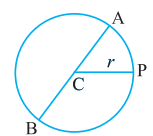Let the centre of a circle C be (alpha, beta ) and its radius r<8. Let 3x+4y=24 and 3x−4y=32 be two tangents and 4x+3y=1 be a normal to C Then (α−β+r) is equal to .
6
7
5
9
The correct Answer is:B
To solve the problem, we need to find the value of α−β+r given the conditions of the circle, tangents, and normal. Let's break down the solution step by step.
Step 1: Identify the equations of the tangents
The equations of the tangents are given as:
1. 3x+4y=24
2. 3x−4y=32
Step 2: Use the formula for the distance from a point to a line
The distance d from the center of the circle (α,β) to the line Ax+By+C=0 is given by:
d=|Aα+Bβ+C|√A2+B2
For the first tangent 3x+4y−24=0:
- A=3,B=4,C=−24
- The distance is:
d1=|3α+4β−24|√32+42=|3α+4β−24|5
For the second tangent 3x−4y−32=0:
- A=3,B=−4,C=−32
- The distance is:
d2=|3α−4β−32|√32+(−4)2=|3α−4β−32|5
Step 3: Set the distances equal to the radius r
Since both lines are tangents to the circle, we have:
|3α+4β−24|5=r
|3α−4β−32|5=r
Step 4: Equate the two expressions
From the above equations, we can set them equal:
|3α+4β−24|=|3α−4β−32|
Step 5: Solve the absolute value equation
This gives us two cases to consider:
Case 1:
3α+4β−24=3α−4β−32
This simplifies to:
8β=−8⟹β=−1
Case 2:
3α+4β−24=−(3α−4β−32)
This simplifies to:
3α+4β−24=−3α+4β+32
6α=56⟹α=283
Step 6: Find the normal to the circle
The normal to the circle is given by the line 4x+3y=1. The normal at the center (α,β) gives us:
4α+3β=1
Substituting β=−1:
4α+3(−1)=1⟹4α−3=1⟹4α=4⟹α=1
Step 7: Calculate the radius r
Using the value of α and β in the distance formula for the first tangent:
r=|3(1)+4(−1)−24|5=|3−4−24|5=|−25|5=5
Step 8: Calculate α−β+r
Now we can find:
α−β+r=1−(−1)+5=1+1+5=7
Final Answer
Thus, the value of α−β+r is 7.
---
The equations of the tangents are given as:
1. 3x+4y=24
2. 3x−4y=32
The distance d from the center of the circle (α,β) to the line Ax+By+C=0 is given by:
d=|Aα+Bβ+C|√A2+B2
- A=3,B=4,C=−24
- The distance is:
d1=|3α+4β−24|√32+42=|3α+4β−24|5
- A=3,B=−4,C=−32
- The distance is:
d2=|3α−4β−32|√32+(−4)2=|3α−4β−32|5
Since both lines are tangents to the circle, we have:
|3α+4β−24|5=r
|3α−4β−32|5=r
From the above equations, we can set them equal:
|3α+4β−24|=|3α−4β−32|
This gives us two cases to consider:
3α+4β−24=3α−4β−32
This simplifies to:
8β=−8⟹β=−1
3α+4β−24=−(3α−4β−32)
This simplifies to:
3α+4β−24=−3α+4β+32
6α=56⟹α=283
The normal to the circle is given by the line 4x+3y=1. The normal at the center (α,β) gives us:
4α+3β=1
Substituting β=−1:
4α+3(−1)=1⟹4α−3=1⟹4α=4⟹α=1
Using the value of α and β in the distance formula for the first tangent:
r=|3(1)+4(−1)−24|5=|3−4−24|5=|−25|5=5
Now we can find:
α−β+r=1−(−1)+5=1+1+5=7
Thus, the value of α−β+r is 7.
Topper's Solved these Questions
Similar Questions
A circle with centre (3α,3β) and of variable radius cuts the rectangular hyperbola x2−y2=9a2 at the points P,Q,S,R. Prove that the locus of the centroid of triangle PQR is (x−2α)2−(y−2β)2=a2.
View SolutionLet α,β be fixed complex numbers and z is a variable complex number such that |z−α|2+|z−β|2=k. Find out the limits for 'k' such that the locus of z is a circle. Find also the centre and radius of the circle
View Solution
Knowledge Check
- Question 1 - Select One
There are two circles touching each other at (1,2) with equal radii 5cm and there is common tangent for these two circles 4x+3y=10. The centres of 1st circle is (α,β) and centre of 2nd circle is (γ,δ). Then find |(α+β)(γ+β)|=?
A20B40C25D35 - Question 2 - Select One
Three poles whose feet lie on a circle subtend angle α,β,γ respectively at the centre of the circle. If the height of the poles are in A.P. then cotα,cotβ,cotγ are in
AA.P.BG.P.CH.P.DNone of these - Question 3 - Select One
If (α,β) is the centre of a circle passing through the origin, then its equation is
Ax2+y2−αx−βy=0Bx2+y2+2αx+2βy=0Cx2+y2−2αx−2βy=0Dx2+y2+αx+βy=0
The diameter of a circle is a line which joins two points on the circle and also passes through the centre of the circle. (In the adjoining figure (Fig 11.12) AB is a diameter of the circle; C is its centre.) Express the diameter of the circle (d) in terms of its radius (r).
 View Solution
View SolutionThe diameter of a circle is a line which joins two points on the circle and also passes through the centre of the circle. (In the adjoining figure, AB is a diameter of the circle, C is its centre.) Express the diameter of the circle (d) in terms of its radius (r).
 View Solution
View SolutionConsider the region R={(x,y)∈R×R:x≥0andy2≤(4−x)}. Let F be the family of all circles that are contained in R and have centers on the x-axis. Let C be the circle that has largest radius among the circles in F Let (α,β) be a point where the circle C meets the curve y2=4−x.
The radius of the circle C is ___View SolutionLet ABCD be a square of side of unit length. Let a circleC1 centered at A with unit radius is drawn. Another circle C2 which touches C1 and the lines AD and AB are tangent to it, is also drawn. Let a tangent line from the point to the circle C2 meet the side AB at E. If the length of EB is α+√3β, where α,β are integers, then α+β is equal to ___________
View SolutionConsider the region R={(x,y)∈R×R:x≥0andy2≤(4−x)}. Let F be the family of all circles that are contained in R and have centers on the x-axis. Let C be the circle that has largest radius among the circles in F Let (α,β) be a point where the circle C meets the curve y2=4−x.
The value of α is ___ .View Solution

